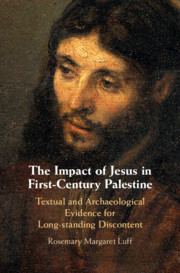 The Impact of Jesus in First-Century Palestine
The Impact of Jesus in First-Century Palestine from Part II - Jesus in Context: The Archaeological Evidence
Published online by Cambridge University Press: 26 July 2019
This chapter explores socio-economic versus halachic explanations for the distribution of ethnic indicators between Judea and Galilee. Fewer miqwa’ot and scant ossuaries have been found in Galilee. Regarding ossuaries, the trickle-down effect from the Judean elite, who had adopted this Roman mode of burial, to the Galilean elite, would have taken time and resulted in smaller and more modest adjustments; this could partially account for any ossuary disparity between Galilee and Judea pre-70 CE. But, more importantly, the difficulties in distinguishing between first-century and second-century Galilean tombs have hampered firm conclusions being made. The miqwa’ot data demonstrate a difference in the interpretation of the Halacha (religious rules), that reflects a diverse Judaism firmly underpinned by a common Judaism identified through a number of archaeological artefacts, such as the Herodian or knife-pared oil lamp common in both Galilee and Judea. The widespread presence of pig bones on Jewish sites, albeit in low numbers, also demonstrates a diverse Judaism. Stone vessels were discovered on all types of site across Judea and Galilee and, with the exception of large jars clearly produced for the wealthy, were used by all classes. This stone vessel revolution has been interpreted as establishing Jewish identity and self-sufficiency.
To save this book to your Kindle, first ensure [email protected] is added to your Approved Personal Document E-mail List under your Personal Document Settings on the Manage Your Content and Devices page of your Amazon account. Then enter the ‘name’ part of your Kindle email address below. Find out more about saving to your Kindle.
Note you can select to save to either the @free.kindle.com or @kindle.com variations. ‘@free.kindle.com’ emails are free but can only be saved to your device when it is connected to wi-fi. ‘@kindle.com’ emails can be delivered even when you are not connected to wi-fi, but note that service fees apply.
Find out more about the Kindle Personal Document Service.
To save content items to your account, please confirm that you agree to abide by our usage policies. If this is the first time you use this feature, you will be asked to authorise Cambridge Core to connect with your account. Find out more about saving content to Dropbox.
To save content items to your account, please confirm that you agree to abide by our usage policies. If this is the first time you use this feature, you will be asked to authorise Cambridge Core to connect with your account. Find out more about saving content to Google Drive.